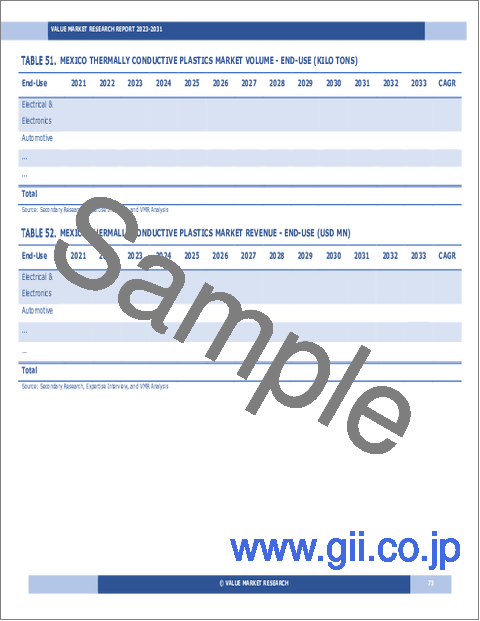|
|
市場調査レポート
商品コード
1782438
熱伝導性プラスチックの世界市場調査レポート:産業分析、規模、シェア、成長、動向、2025年~2033年の予測Global Thermally Conductive Plastics Market Research Report- Industry Analysis, Size, Share, Growth, Trends and Forecast 2025 to 2033 |
||||||
カスタマイズ可能
|
|||||||
| 熱伝導性プラスチックの世界市場調査レポート:産業分析、規模、シェア、成長、動向、2025年~2033年の予測 |
|
出版日: 2025年08月01日
発行: Value Market Research
ページ情報: 英文 166 Pages
納期: 即日から翌営業日
|
全表示
- 概要
- 図表
- 目次
熱伝導性プラスチックの世界市場規模は、2024年の1億9,117万米ドルから2033年には5億6,431万米ドルに成長し、2026年から2033年の予測期間中に12.78%の堅調な年間平均成長率(CAGR)を示すと予測されています。
熱伝導性プラスチック市場は、産業界が熱管理用途に軽量で効率的な材料を求めるようになっていることから、大きな成長が見込まれています。効果的な放熱を必要とする電子機器や部品の需要が高まる中、熱伝導性プラスチックは自動車、電子機器、航空宇宙などの分野で不可欠な存在となっています。これらの材料は、軽量特性と熱伝導性のユニークな組み合わせを提供し、従来の金属では重すぎたり、扱いにくかったりする用途に最適です。メーカーが技術革新を続け、高度な配合を開発するにつれて、効率的な熱管理ソリューションの必要性に後押しされ、市場は拡大すると予想されます。
さらに、エネルギー効率と持続可能性を重視する傾向が強まっていることも、熱伝導性プラスチック市場に影響を与えています。産業界がカーボンフットプリントの削減に努める中、エネルギー効率を高める軽量材料の採用が優先課題となっています。熱伝導性プラスチックは効果的な熱管理を実現するだけでなく、電気自動車や再生可能エネルギーシステムなどの用途において、全体的なエネルギー節約にも貢献します。この動向は、持続可能な素材に対する需要の高まりに対応した環境に優しい配合を生み出すための研究開発にメーカーが投資することを促しています。
さらに、家電や通信などの分野における技術の急速な進歩が、熱伝導性プラスチック市場をさらに後押ししています。機器の小型化・高性能化に伴い、最適な性能と信頼性を確保するためには、効果的な熱管理ソリューションが不可欠となっています。ヒートシンク、ハウジング、その他の部品の設計に熱伝導性プラスチックを組み込むことが一般的になりつつあり、技術革新と市場成長の原動力となっています。このように、熱伝導性プラスチック市場は、技術の進歩、持続可能性への取り組み、さまざまな産業における効率的な熱管理ソリューションへの需要の高まりによって、大幅な拡大が見込まれています。
当レポートは、様々な産業や市場に関する包括的かつ実用的な洞察をお客様に提供できるよう、綿密に作成されています。各レポートは、市場情勢を完全に理解するために、いくつかの重要な要素を含んでいます:
市場概要:定義、分類、業界の現状に関する概要など、市場に関する詳細なイントロダクション。
市場力学:市場成長に影響を与える主な促進要因・抑制要因・機会・課題を詳細に分析します。このセクションでは、技術の進歩、規制の変更、新たな動向などの要因を検証します。
セグメンテーション分析:製品タイプ、用途、エンドユーザー、地域などの基準に基づき、市場を明確なセグメントに内訳。この分析により、各セグメントの業績と将来性を明らかにします。
競合情勢:市場シェア、製品ポートフォリオ、戦略的イニシアティブ、財務実績など、主要市場プレイヤーの包括的評価。主要企業が採用する競合力学と主要戦略に関する考察を提供します。
市場予測:過去のデータと現在の市場状況に基づき、一定期間における市場規模と成長動向を予測します。これには、定量的分析と将来の市場軌跡を示すグラフ表示が含まれます。
地域分析:地域ごとの市場パフォーマンスを評価し、主要市場や地域動向を明らかにします。地域の市場力学とビジネスチャンスを理解するのに役立ちます。
新たな動向と機会:現在の市場動向と新たな市場動向、技術革新、潜在的な投資対象分野を特定します。将来の市場開拓と成長見通しに関する洞察を提供します。
目次
第1章 序文
第2章 エグゼクティブサマリー
- 市場のハイライト
- 世界市場スナップショット
第3章 熱伝導性プラスチック産業分析
- イントロダクション:市場力学
- 市場促進要因
- 市場抑制要因
- 市場機会
- 業界動向
- ポーターのファイブフォース分析
- 市場の魅力分析
第4章 バリューチェーン分析
- バリューチェーン分析
- 原材料分析
- 原材料リスト
- 原材料メーカーリスト
- 主要原材料の価格動向
- 潜在的バイヤーリスト
- マーケティングチャネル
- ダイレクトマーケティング
- インダイレクトマーケティング
- マーケティングチャネル発展動向
第5章 熱伝導性プラスチックの世界市場分析:タイプ別
- タイプ別概要
- タイプ別過去および予測データ分析
- ポリアミド(PA)
- ポリカーボネート(PC)
- ポリブチレンテレフタレート(PBT)
- ポリフェニレンサルファイド(PPS)
- ポリエーテルイミド(PEI)
- その他
第6章 熱伝導性プラスチックの世界市場分析:最終用途別
- 最終用途別概要
- 最終用途別過去および予測データ分析
- 電気・電子
- 自動車
- 産業用
- ヘルスケア
- 航空宇宙
- その他
第7章 熱伝導性プラスチックの世界市場分析:地域別
- 地域別展望
- イントロダクション
- 北米の売上分析
- 概要、実績と予測
- 北米:セグメント別
- 北米国別
- 米国
- カナダ
- メキシコ
- 欧州売上分析
- 概要、実績と予測
- 欧州セグメント別
- 欧州国別
- 英国
- フランス
- ドイツ
- イタリア
- ロシア
- その他欧州
- アジア太平洋地域売上分析
- 概要、実績と予測
- アジア太平洋地域セグメント別
- アジア太平洋地域国別
- 中国
- インド
- 日本
- 韓国
- オーストラリア
- 東南アジア
- その他アジア太平洋地域
- ラテンアメリカ売上分析
- 概要、実績と予測
- ラテンアメリカ:セグメント別
- ラテンアメリカ国別
- ブラジル
- アルゼンチン
- ペルー
- チリ
- その他ラテンアメリカ
- 中東・アフリカ売上分析
- 概要、実績と予測
- 中東・アフリカセグメント別
- 中東・アフリカ国別一覧
- サウジアラビア
- アラブ首長国連邦
- イスラエル
- 南アフリカ
- その他中東とアフリカ
第8章 熱伝導性プラスチック企業の競合情勢
- 熱伝導性プラスチック市場の競合
- 提携・協力・協定
- 合併・買収
- 新製品の発売
- その他の開発
第9章 企業プロファイル
- 上位企業の市場シェア分析
- 市場集中度
- Celanese Corporation
- DSM
- SABIC
- BASF SE
- DuPont
- LANXESS AG
- Ensinger
- TORAY INDUSTRIES
- INC
- KANEKA CORPORATION
- RTP Company
- Mitsubishi Engineering-Plastics Corporation
- Nytex Composites Co. Ltd
LIST OF TABLES
- Market Snapshot
- Drivers: Impact Analysis
- Restraints: Impact Analysis
- List of Raw Material
- List of Raw Material Manufactures
- Analysis By Type (Kilo Tons and USD MN)
- Polyamide (PA) Market Sales By Geography (Kilo Tons and USD MN)
- Polycarbonate (PC) Market Sales By Geography (Kilo Tons and USD MN)
- Polybutylene Terephthalate (PBT) Market Sales By Geography (Kilo Tons and USD MN)
- Polyphenylene Sulfide (PPS) Market Sales By Geography (Kilo Tons and USD MN)
- Polyetherimide (PEI) Market Sales By Geography (Kilo Tons and USD MN)
- Others Market Sales By Geography (Kilo Tons and USD MN)
- Analysis By End-Use (Kilo Tons and USD MN)
- Electrical & Electronics Market Sales By Geography (Kilo Tons and USD MN)
- Automotive Market Sales By Geography (Kilo Tons and USD MN)
- Industrial Market Sales By Geography (Kilo Tons and USD MN)
- Healthcare Market Sales By Geography (Kilo Tons and USD MN)
- Aerospace Market Sales By Geography (Kilo Tons and USD MN)
- Others Market Sales By Geography (Kilo Tons and USD MN)
- Global Thermally Conductive Plastics Market Sales By Geography (Kilo Tons and USD MN)
- North America Market Analysis (Kilo Tons and USD MN)
- United States Market Analysis (Kilo Tons and USD MN)
- Canada Market Analysis (Kilo Tons and USD MN)
- Mexico Market Analysis (Kilo Tons and USD MN)
- Europe Market Analysis (Kilo Tons and USD MN)
- Europe Market Estimate By Country (Kilo Tons and USD MN)
- United Kingdom Market Analysis (Kilo Tons and USD MN)
- France Market Analysis (Kilo Tons and USD MN)
- Germany Market Analysis (Kilo Tons and USD MN)
- Italy Market Analysis (Kilo Tons and USD MN)
- Russia Market Analysis (Kilo Tons and USD MN)
- Spain Market Analysis (Kilo Tons and USD MN)
- Rest of Europe Market Analysis (Kilo Tons and USD MN)
- Asia Pacific Market Analysis (Kilo Tons and USD MN)
- China Market Analysis (Kilo Tons and USD MN)
- Japan Market Analysis (Kilo Tons and USD MN)
- India Market Analysis (Kilo Tons and USD MN)
- South Korea Market Analysis (Kilo Tons and USD MN)
- Australia Market Analysis (Kilo Tons and USD MN)
- South East Asia Market Analysis (Kilo Tons and USD MN)
- Rest of Asia Pacific Market Analysis (Kilo Tons and USD MN)
- Latin America Market Analysis (Kilo Tons and USD MN)
- Brazil Market Analysis (Kilo Tons and USD MN)
- Argentina Market Analysis (Kilo Tons and USD MN)
- Peru Market Analysis (Kilo Tons and USD MN)
- Chile Market Analysis (Kilo Tons and USD MN)
- Rest of Latin America Market Analysis (Kilo Tons and USD MN)
- Middle East & Africa Market Analysis (Kilo Tons and USD MN)
- Saudi Arabia Market Analysis (Kilo Tons and USD MN)
- UAE Market Analysis (Kilo Tons and USD MN)
- Israel Market Analysis (Kilo Tons and USD MN)
- South Africa Market Analysis (Kilo Tons and USD MN)
- Rest of Middle East and Africa Market Analysis (Kilo Tons and USD MN)
- Partnership/Collaboration/Agreement
- Mergers And Acquisition
LIST OF FIGURES
- Research Scope of Thermally Conductive Plastics Report
- Market Research Process
- Market Research Methodology
- Global Thermally Conductive Plastics Market Size, By Regions (Kilo Tons and USD MN)
- Porters Five Forces Analysis
- Market Attractiveness Analysis By Type
- Market Attractiveness Analysis By End-Use
- Market Attractiveness Analysis By Regions
- Value Chain Analysis
- Global Market Analysis By Type (Kilo Tons and USD MN)
- Polyamide (PA) Market Sales By Geography (Kilo Tons and USD MN)
- Polycarbonate (PC) Market Sales By Geography (Kilo Tons and USD MN)
- Polybutylene Terephthalate (PBT) Market Sales By Geography (Kilo Tons and USD MN)
- Polyphenylene Sulfide (PPS) Market Sales By Geography (Kilo Tons and USD MN)
- Polyetherimide (PEI) Market Sales By Geography (Kilo Tons and USD MN)
- Others Market Sales By Geography (Kilo Tons and USD MN)
- Global Market Analysis By End-Use (Kilo Tons and USD MN)
- Electrical & Electronics Market Sales By Geography (Kilo Tons and USD MN)
- Automotive Market Sales By Geography (Kilo Tons and USD MN)
- Industrial Market Sales By Geography (Kilo Tons and USD MN)
- Healthcare Market Sales By Geography (Kilo Tons and USD MN)
- Aerospace Market Sales By Geography (Kilo Tons and USD MN)
- Others Market Sales By Geography (Kilo Tons and USD MN)
- Global Market Sales (Kilo Tons and USD MN)
- North America Market Sales (Kilo Tons and USD MN)
- Europe Market Sales (Kilo Tons and USD MN)
- Asia Pacific Market Sales (Kilo Tons and USD MN)
- Latin America Market Sales (Kilo Tons and USD MN)
- Middle East & Africa Market Sales (Kilo Tons and USD MN)
- Recent Development in Industry
- Top Company Market Share Analysis
Kindly note that the above listed are the basic tables and figures of the report and are not limited to the TOC.
Global Thermally Conductive Plastics Market size is anticipated to grow from USD 191.17 Million in 2024 to USD 564.31 Million by 2033, showcasing a robust Compound Annual Growth Rate (CAGR) of 12.78% during the forecast period of 2026 to 2033.
The thermally conductive plastics market is poised for significant growth as industries increasingly seek lightweight and efficient materials for thermal management applications. With the rising demand for electronic devices and components that require effective heat dissipation, thermally conductive plastics are becoming essential in sectors such as automotive, electronics, and aerospace. These materials offer a unique combination of lightweight properties and thermal conductivity, making them ideal for applications where traditional metals may be too heavy or cumbersome. As manufacturers continue to innovate and develop advanced formulations, the market is expected to expand, driven by the need for efficient thermal management solutions.
Moreover, the increasing emphasis on energy efficiency and sustainability is influencing the thermally conductive plastics market. As industries strive to reduce their carbon footprint, the adoption of lightweight materials that enhance energy efficiency is becoming a priority. Thermally conductive plastics not only provide effective heat management but also contribute to overall energy savings in applications such as electric vehicles and renewable energy systems. This trend is prompting manufacturers to invest in research and development to create eco-friendly formulations that meet the growing demand for sustainable materials.
Additionally, the rapid advancement of technology in sectors such as consumer electronics and telecommunications is further propelling the thermally conductive plastics market. As devices become more compact and powerful, the need for effective thermal management solutions is critical to ensure optimal performance and reliability. The integration of thermally conductive plastics in the design of heat sinks, housings, and other components is becoming increasingly common, driving innovation and market growth. The thermally conductive plastics market is thus positioned for substantial expansion, fueled by technological advancements, sustainability initiatives, and the growing demand for efficient thermal management solutions across various industries.
Our reports are meticulously crafted to provide clients with comprehensive and actionable insights into various industries and markets. Each report encompasses several critical components to ensure a thorough understanding of the market landscape:
Market Overview: A detailed introduction to the market, including definitions, classifications, and an overview of the industry's current state.
Market Dynamics: In-depth analysis of key drivers, restraints, opportunities, and challenges influencing market growth. This section examines factors such as technological advancements, regulatory changes, and emerging trends.
Segmentation Analysis: Breakdown of the market into distinct segments based on criteria like product type, application, end-user, and geography. This analysis highlights the performance and potential of each segment.
Competitive Landscape: Comprehensive assessment of major market players, including their market share, product portfolio, strategic initiatives, and financial performance. This section provides insights into the competitive dynamics and key strategies adopted by leading companies.
Market Forecast: Projections of market size and growth trends over a specified period, based on historical data and current market conditions. This includes quantitative analyses and graphical representations to illustrate future market trajectories.
Regional Analysis: Evaluation of market performance across different geographical regions, identifying key markets and regional trends. This helps in understanding regional market dynamics and opportunities.
Emerging Trends and Opportunities: Identification of current and emerging market trends, technological innovations, and potential areas for investment. This section offers insights into future market developments and growth prospects.
SEGMENTATION COVERED IN THE REPORT
By Type
- Polyamide (PA)
- Polycarbonate (PC)
- Polybutylene Terephthalate (PBT)
- Polyphenylene Sulfide (PPS)
- Polyetherimide (PEI)
- Others
By End-Use
- Electrical & Electronics
- Automotive
- Industrial
- Healthcare
- Aerospace
- Others
- COMPANIES PROFILED
- Celanese Corporation
- DSM
- SABIC
- BASF SE
- DuPont
- LANXESS AG
- Ensinger
- TORAY INDUSTRIES
- INC
- KANEKA CORPORATION
- RTP Company
- Mitsubishi Engineering-Plastics Corporation
- Nytex Composites Co. Ltd.
- The above list can be customized.
TABLE OF CONTENTS
1. PREFACE
- 1.1. Report Description
- 1.1.1 Objective
- 1.1.2 Target Audience
- 1.1.3 Unique Selling Proposition (USP) & offerings
- 1.2. Research Scope
- 1.3. Research Methodology
- 1.3.1 Market Research Process
- 1.3.2 Market Research Methodology
2. EXECUTIVE SUMMARY
- 2.1. Highlights of Market
- 2.2. Global Market Snapshot
3. THERMALLY CONDUCTIVE PLASTICS INDUSTRY ANALYSIS
- 3.1. Introduction - Market Dynamics
- 3.2. Market Drivers
- 3.3. Market Restraints
- 3.4. Opportunities
- 3.5. Industry Trends
- 3.6. Porter's Five Force Analysis
- 3.7. Market Attractiveness Analysis
- 3.7.1 Market Attractiveness Analysis By Type
- 3.7.2 Market Attractiveness Analysis By End-Use
- 3.7.3 Market Attractiveness Analysis By Regions
4. VALUE CHAIN ANALYSIS
- 4.1. Value Chain Analysis
- 4.2. Raw Material Analysis
- 4.2.1 List of Raw Materials
- 4.2.2 Raw Material Manufactures List
- 4.2.3 Price Trend of Key Raw Materials
- 4.3. List of Potential Buyers
- 4.4. Marketing Channel
- 4.4.1 Direct Marketing
- 4.4.2 Indirect Marketing
- 4.4.3 Marketing Channel Development Trend
5. GLOBAL THERMALLY CONDUCTIVE PLASTICS MARKET ANALYSIS BY TYPE
- 5.1. Overview By Type
- 5.2. Historical and Forecast Data Analysis By Type
- 5.3. Polyamide (PA) Historic and Forecast Sales By Regions
- 5.4. Polycarbonate (PC) Historic and Forecast Sales By Regions
- 5.5. Polybutylene Terephthalate (PBT) Historic and Forecast Sales By Regions
- 5.6. Polyphenylene Sulfide (PPS) Historic and Forecast Sales By Regions
- 5.7. Polyetherimide (PEI) Historic and Forecast Sales By Regions
- 5.8. Others Historic and Forecast Sales By Regions
6. GLOBAL THERMALLY CONDUCTIVE PLASTICS MARKET ANALYSIS BY END-USE
- 6.1. Overview By End-Use
- 6.2. Historical and Forecast Data Analysis By End-Use
- 6.3. Electrical & Electronics Historic and Forecast Sales By Regions
- 6.4. Automotive Historic and Forecast Sales By Regions
- 6.5. Industrial Historic and Forecast Sales By Regions
- 6.6. Healthcare Historic and Forecast Sales By Regions
- 6.7. Aerospace Historic and Forecast Sales By Regions
- 6.8. Others Historic and Forecast Sales By Regions
7. GLOBAL THERMALLY CONDUCTIVE PLASTICS MARKET ANALYSIS BY GEOGRAPHY
- 7.1. Regional Outlook
- 7.2. Introduction
- 7.3. North America Sales Analysis
- 7.3.1 Overview, Historic and Forecast Data Sales Analysis
- 7.3.2 North America By Segment Sales Analysis
- 7.3.3 North America By Country Sales Analysis
- 7.3.4 United States Sales Analysis
- 7.3.5 Canada Sales Analysis
- 7.3.6 Mexico Sales Analysis
- 7.4. Europe Sales Analysis
- 7.4.1 Overview, Historic and Forecast Data Sales Analysis
- 7.4.2 Europe By Segment Sales Analysis
- 7.4.3 Europe By Country Sales Analysis
- 7.4.4 United Kingdom Sales Analysis
- 7.4.5 France Sales Analysis
- 7.4.6 Germany Sales Analysis
- 7.4.7 Italy Sales Analysis
- 7.4.8 Russia Sales Analysis
- 7.4.9 Rest Of Europe Sales Analysis
- 7.5. Asia Pacific Sales Analysis
- 7.5.1 Overview, Historic and Forecast Data Sales Analysis
- 7.5.2 Asia Pacific By Segment Sales Analysis
- 7.5.3 Asia Pacific By Country Sales Analysis
- 7.5.4 China Sales Analysis
- 7.5.5 India Sales Analysis
- 7.5.6 Japan Sales Analysis
- 7.5.7 South Korea Sales Analysis
- 7.5.8 Australia Sales Analysis
- 7.5.9 South East Asia Sales Analysis
- 7.5.10 Rest Of Asia Pacific Sales Analysis
- 7.6. Latin America Sales Analysis
- 7.6.1 Overview, Historic and Forecast Data Sales Analysis
- 7.6.2 Latin America By Segment Sales Analysis
- 7.6.3 Latin America By Country Sales Analysis
- 7.6.4 Brazil Sales Analysis
- 7.6.5 Argentina Sales Analysis
- 7.6.6 Peru Sales Analysis
- 7.6.7 Chile Sales Analysis
- 7.6.8 Rest of Latin America Sales Analysis
- 7.7. Middle East & Africa Sales Analysis
- 7.7.1 Overview, Historic and Forecast Data Sales Analysis
- 7.7.2 Middle East & Africa By Segment Sales Analysis
- 7.7.3 Middle East & Africa By Country Sales Analysis
- 7.7.4 Saudi Arabia Sales Analysis
- 7.7.5 UAE Sales Analysis
- 7.7.6 Israel Sales Analysis
- 7.7.7 South Africa Sales Analysis
- 7.7.8 Rest Of Middle East And Africa Sales Analysis
8. COMPETITIVE LANDSCAPE OF THE THERMALLY CONDUCTIVE PLASTICS COMPANIES
- 8.1. Thermally Conductive Plastics Market Competition
- 8.2. Partnership/Collaboration/Agreement
- 8.3. Merger And Acquisitions
- 8.4. New Product Launch
- 8.5. Other Developments
9. COMPANY PROFILES OF THERMALLY CONDUCTIVE PLASTICS INDUSTRY
- 9.1. Top Companies Market Share Analysis
- 9.2. Market Concentration Rate
- 9.3. Celanese Corporation
- 9.3.1 Company Overview
- 9.3.2 Company Revenue
- 9.3.3 Products
- 9.3.4 Recent Developments
- 9.4. DSM
- 9.4.1 Company Overview
- 9.4.2 Company Revenue
- 9.4.3 Products
- 9.4.4 Recent Developments
- 9.5. SABIC
- 9.5.1 Company Overview
- 9.5.2 Company Revenue
- 9.5.3 Products
- 9.5.4 Recent Developments
- 9.6. BASF SE
- 9.6.1 Company Overview
- 9.6.2 Company Revenue
- 9.6.3 Products
- 9.6.4 Recent Developments
- 9.7. DuPont
- 9.7.1 Company Overview
- 9.7.2 Company Revenue
- 9.7.3 Products
- 9.7.4 Recent Developments
- 9.8. LANXESS AG
- 9.8.1 Company Overview
- 9.8.2 Company Revenue
- 9.8.3 Products
- 9.8.4 Recent Developments
- 9.9. Ensinger
- 9.9.1 Company Overview
- 9.9.2 Company Revenue
- 9.9.3 Products
- 9.9.4 Recent Developments
- 9.10. TORAY INDUSTRIES
- 9.10.1 Company Overview
- 9.10.2 Company Revenue
- 9.10.3 Products
- 9.10.4 Recent Developments
- 9.11. INC
- 9.11.1 Company Overview
- 9.11.2 Company Revenue
- 9.11.3 Products
- 9.11.4 Recent Developments
- 9.12. KANEKA CORPORATION
- 9.12.1 Company Overview
- 9.12.2 Company Revenue
- 9.12.3 Products
- 9.12.4 Recent Developments
- 9.13. RTP Company
- 9.13.1 Company Overview
- 9.13.2 Company Revenue
- 9.13.3 Products
- 9.13.4 Recent Developments
- 9.14. Mitsubishi Engineering-Plastics Corporation
- 9.14.1 Company Overview
- 9.14.2 Company Revenue
- 9.14.3 Products
- 9.14.4 Recent Developments
- 9.15. Nytex Composites Co. Ltd
- 9.15.1 Company Overview
- 9.15.2 Company Revenue
- 9.15.3 Products
- 9.15.4 Recent Developments






